Leadership Report: Leadership Analysis for Tesco (Module Report)
VerifiedAdded on 2022/11/23
|12
|2457
|3
Report
AI Summary
This leadership report provides a detailed analysis of leadership within Tesco, a leading international retail company. The report begins with an introduction defining leadership and outlining the scope of the analysis, which includes examining leadership styles such as autocratic, democratic, bureaucratic, and laissez-faire. It then explores various leadership theories and models, including contingency theory, transactional theory, transformational theory, and trait theory. The report further investigates the impact of leadership on organizational performance and business practices, such as efficient operations, effective management, improved productivity, and enhanced functioning. The application of leadership to different organizational situations, like new product launches and work-from-home scenarios, is also discussed. Additionally, the report delves into motivation theories, including Victor Vroom's expectancy theory and Adam's equity theory, and their practical applications. The impact of leadership on organizational culture and diversity management within Tesco is examined, focusing on cultural functions, organizational performance culture, and leader influence culture. Finally, the report assesses the impact of the external environment, including political, economic, social, technological, legal, and environmental factors, on creating an inclusive work culture. The report concludes by summarizing the key findings and emphasizing the importance of understanding and applying leadership principles for improved organizational outcomes.
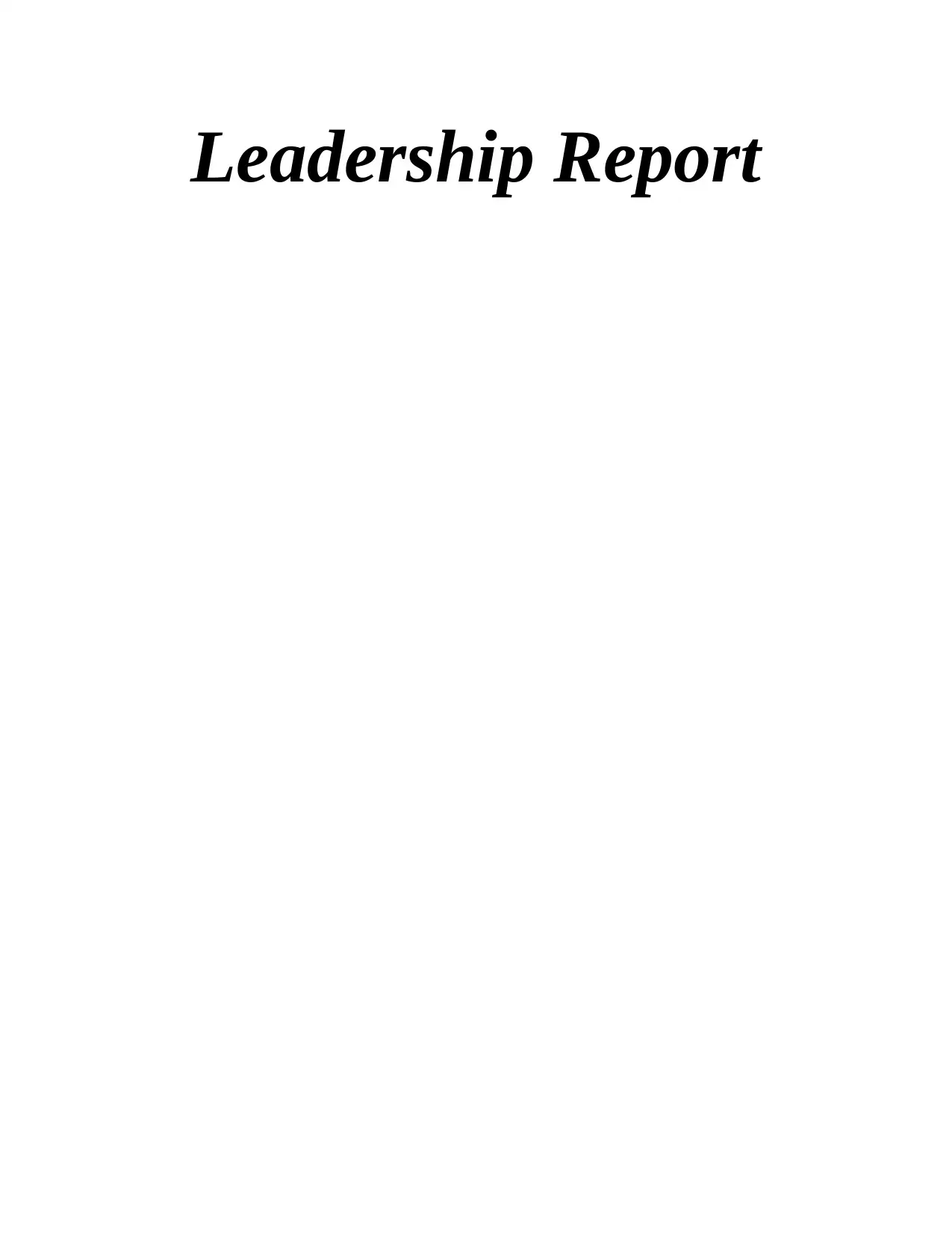
Leadership Report
Paraphrase This Document
Need a fresh take? Get an instant paraphrase of this document with our AI Paraphraser

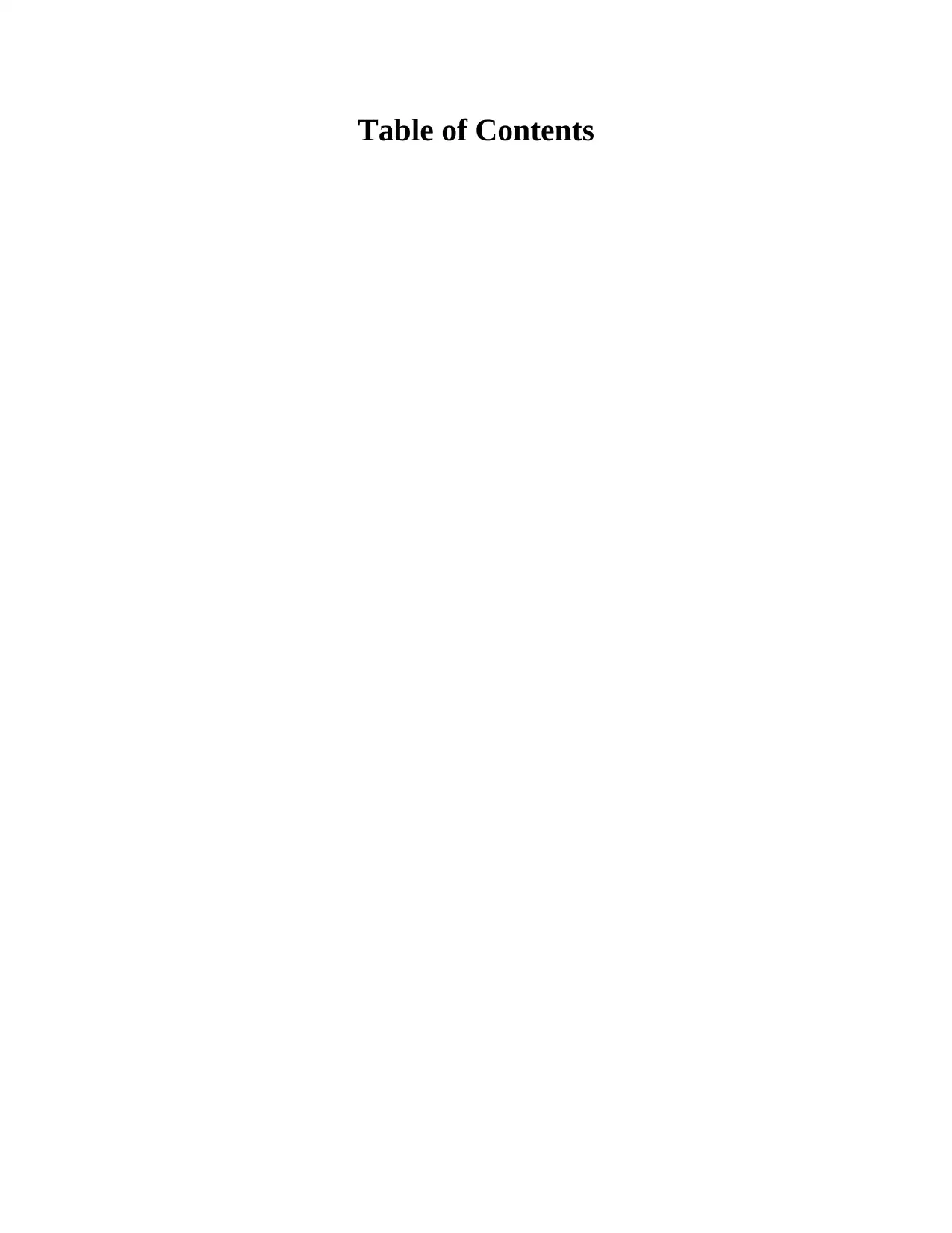
Table of Contents
⊘ This is a preview!⊘
Do you want full access?
Subscribe today to unlock all pages.

Trusted by 1+ million students worldwide
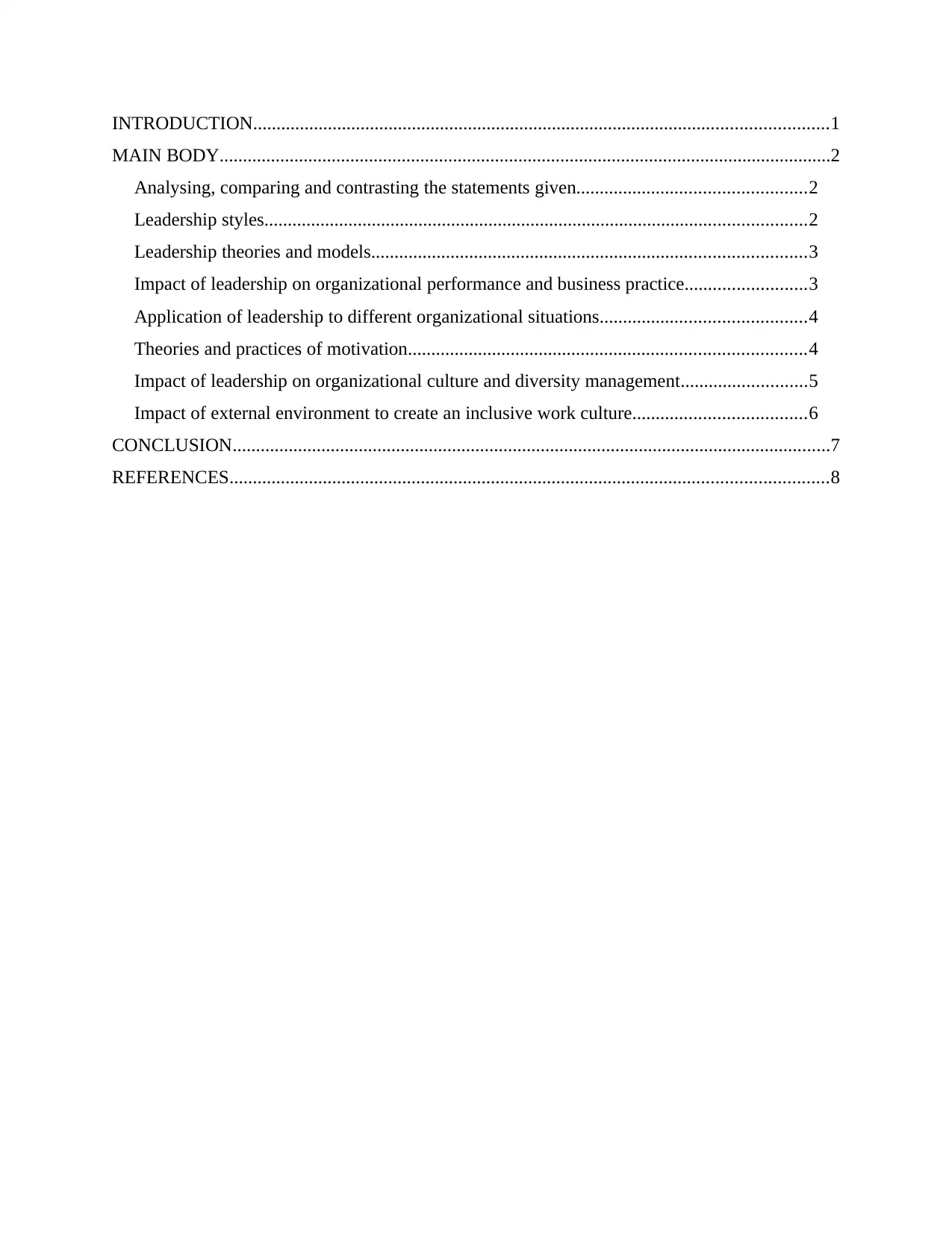
INTRODUCTION...........................................................................................................................1
MAIN BODY...................................................................................................................................2
Analysing, comparing and contrasting the statements given.................................................2
Leadership styles....................................................................................................................2
Leadership theories and models.............................................................................................3
Impact of leadership on organizational performance and business practice..........................3
Application of leadership to different organizational situations............................................4
Theories and practices of motivation.....................................................................................4
Impact of leadership on organizational culture and diversity management...........................5
Impact of external environment to create an inclusive work culture.....................................6
CONCLUSION................................................................................................................................7
REFERENCES................................................................................................................................8
MAIN BODY...................................................................................................................................2
Analysing, comparing and contrasting the statements given.................................................2
Leadership styles....................................................................................................................2
Leadership theories and models.............................................................................................3
Impact of leadership on organizational performance and business practice..........................3
Application of leadership to different organizational situations............................................4
Theories and practices of motivation.....................................................................................4
Impact of leadership on organizational culture and diversity management...........................5
Impact of external environment to create an inclusive work culture.....................................6
CONCLUSION................................................................................................................................7
REFERENCES................................................................................................................................8
Paraphrase This Document
Need a fresh take? Get an instant paraphrase of this document with our AI Paraphraser
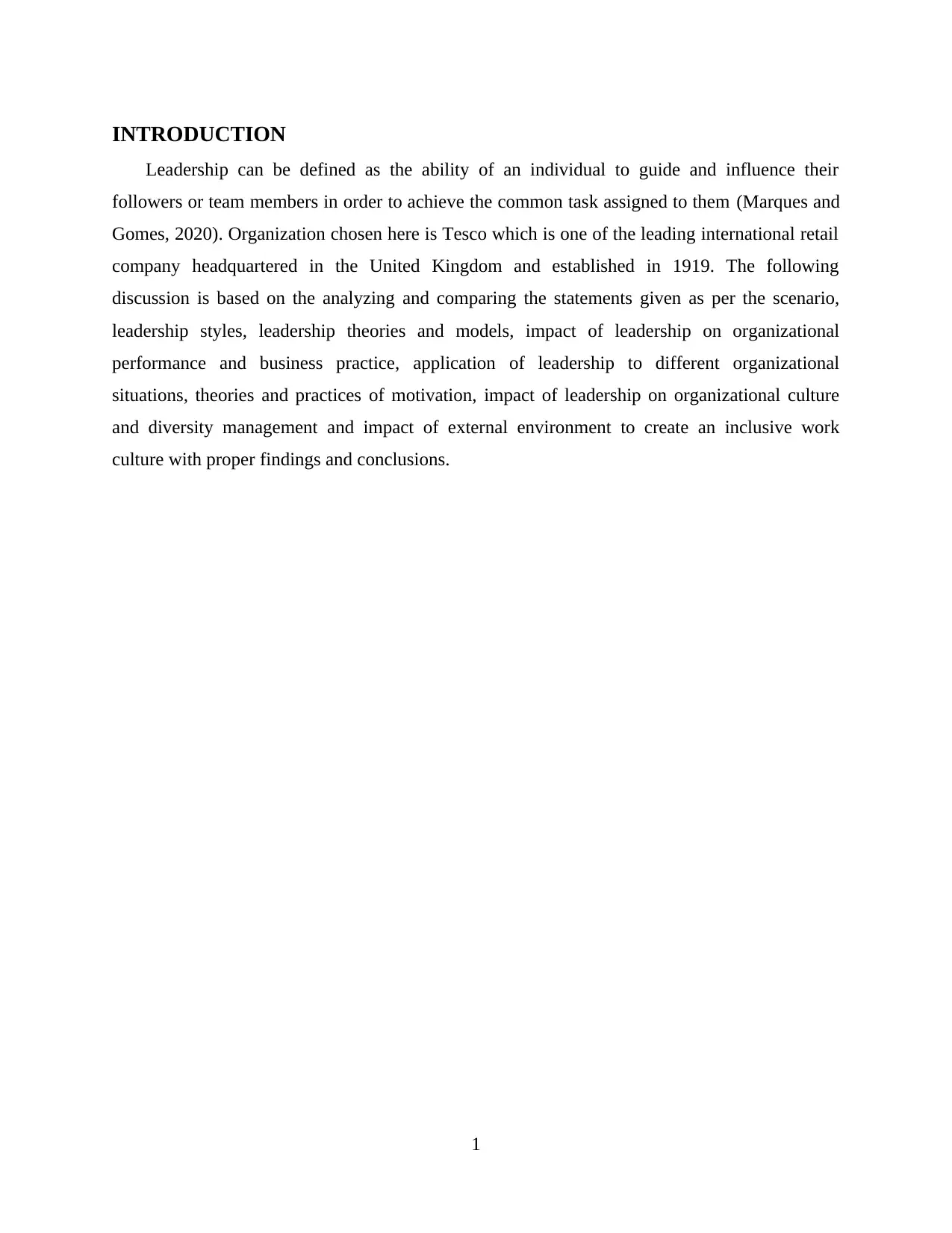
INTRODUCTION
Leadership can be defined as the ability of an individual to guide and influence their
followers or team members in order to achieve the common task assigned to them (Marques and
Gomes, 2020). Organization chosen here is Tesco which is one of the leading international retail
company headquartered in the United Kingdom and established in 1919. The following
discussion is based on the analyzing and comparing the statements given as per the scenario,
leadership styles, leadership theories and models, impact of leadership on organizational
performance and business practice, application of leadership to different organizational
situations, theories and practices of motivation, impact of leadership on organizational culture
and diversity management and impact of external environment to create an inclusive work
culture with proper findings and conclusions.
1
Leadership can be defined as the ability of an individual to guide and influence their
followers or team members in order to achieve the common task assigned to them (Marques and
Gomes, 2020). Organization chosen here is Tesco which is one of the leading international retail
company headquartered in the United Kingdom and established in 1919. The following
discussion is based on the analyzing and comparing the statements given as per the scenario,
leadership styles, leadership theories and models, impact of leadership on organizational
performance and business practice, application of leadership to different organizational
situations, theories and practices of motivation, impact of leadership on organizational culture
and diversity management and impact of external environment to create an inclusive work
culture with proper findings and conclusions.
1
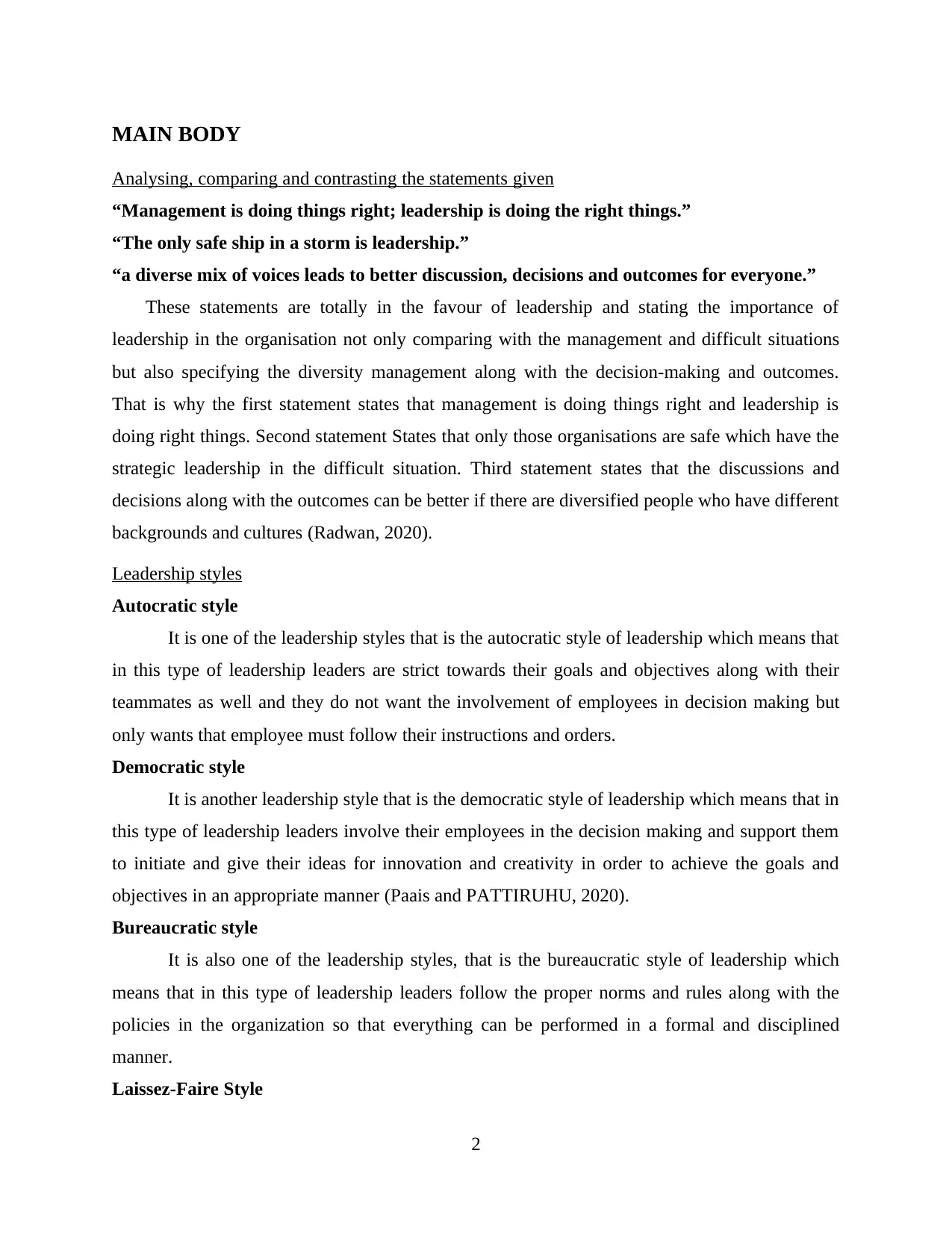
MAIN BODY
Analysing, comparing and contrasting the statements given
“Management is doing things right; leadership is doing the right things.”
“The only safe ship in a storm is leadership.”
“a diverse mix of voices leads to better discussion, decisions and outcomes for everyone.”
These statements are totally in the favour of leadership and stating the importance of
leadership in the organisation not only comparing with the management and difficult situations
but also specifying the diversity management along with the decision-making and outcomes.
That is why the first statement states that management is doing things right and leadership is
doing right things. Second statement States that only those organisations are safe which have the
strategic leadership in the difficult situation. Third statement states that the discussions and
decisions along with the outcomes can be better if there are diversified people who have different
backgrounds and cultures (Radwan, 2020).
Leadership styles
Autocratic style
It is one of the leadership styles that is the autocratic style of leadership which means that
in this type of leadership leaders are strict towards their goals and objectives along with their
teammates as well and they do not want the involvement of employees in decision making but
only wants that employee must follow their instructions and orders.
Democratic style
It is another leadership style that is the democratic style of leadership which means that in
this type of leadership leaders involve their employees in the decision making and support them
to initiate and give their ideas for innovation and creativity in order to achieve the goals and
objectives in an appropriate manner (Paais and PATTIRUHU, 2020).
Bureaucratic style
It is also one of the leadership styles, that is the bureaucratic style of leadership which
means that in this type of leadership leaders follow the proper norms and rules along with the
policies in the organization so that everything can be performed in a formal and disciplined
manner.
Laissez-Faire Style
2
Analysing, comparing and contrasting the statements given
“Management is doing things right; leadership is doing the right things.”
“The only safe ship in a storm is leadership.”
“a diverse mix of voices leads to better discussion, decisions and outcomes for everyone.”
These statements are totally in the favour of leadership and stating the importance of
leadership in the organisation not only comparing with the management and difficult situations
but also specifying the diversity management along with the decision-making and outcomes.
That is why the first statement states that management is doing things right and leadership is
doing right things. Second statement States that only those organisations are safe which have the
strategic leadership in the difficult situation. Third statement states that the discussions and
decisions along with the outcomes can be better if there are diversified people who have different
backgrounds and cultures (Radwan, 2020).
Leadership styles
Autocratic style
It is one of the leadership styles that is the autocratic style of leadership which means that
in this type of leadership leaders are strict towards their goals and objectives along with their
teammates as well and they do not want the involvement of employees in decision making but
only wants that employee must follow their instructions and orders.
Democratic style
It is another leadership style that is the democratic style of leadership which means that in
this type of leadership leaders involve their employees in the decision making and support them
to initiate and give their ideas for innovation and creativity in order to achieve the goals and
objectives in an appropriate manner (Paais and PATTIRUHU, 2020).
Bureaucratic style
It is also one of the leadership styles, that is the bureaucratic style of leadership which
means that in this type of leadership leaders follow the proper norms and rules along with the
policies in the organization so that everything can be performed in a formal and disciplined
manner.
Laissez-Faire Style
2
⊘ This is a preview!⊘
Do you want full access?
Subscribe today to unlock all pages.

Trusted by 1+ million students worldwide
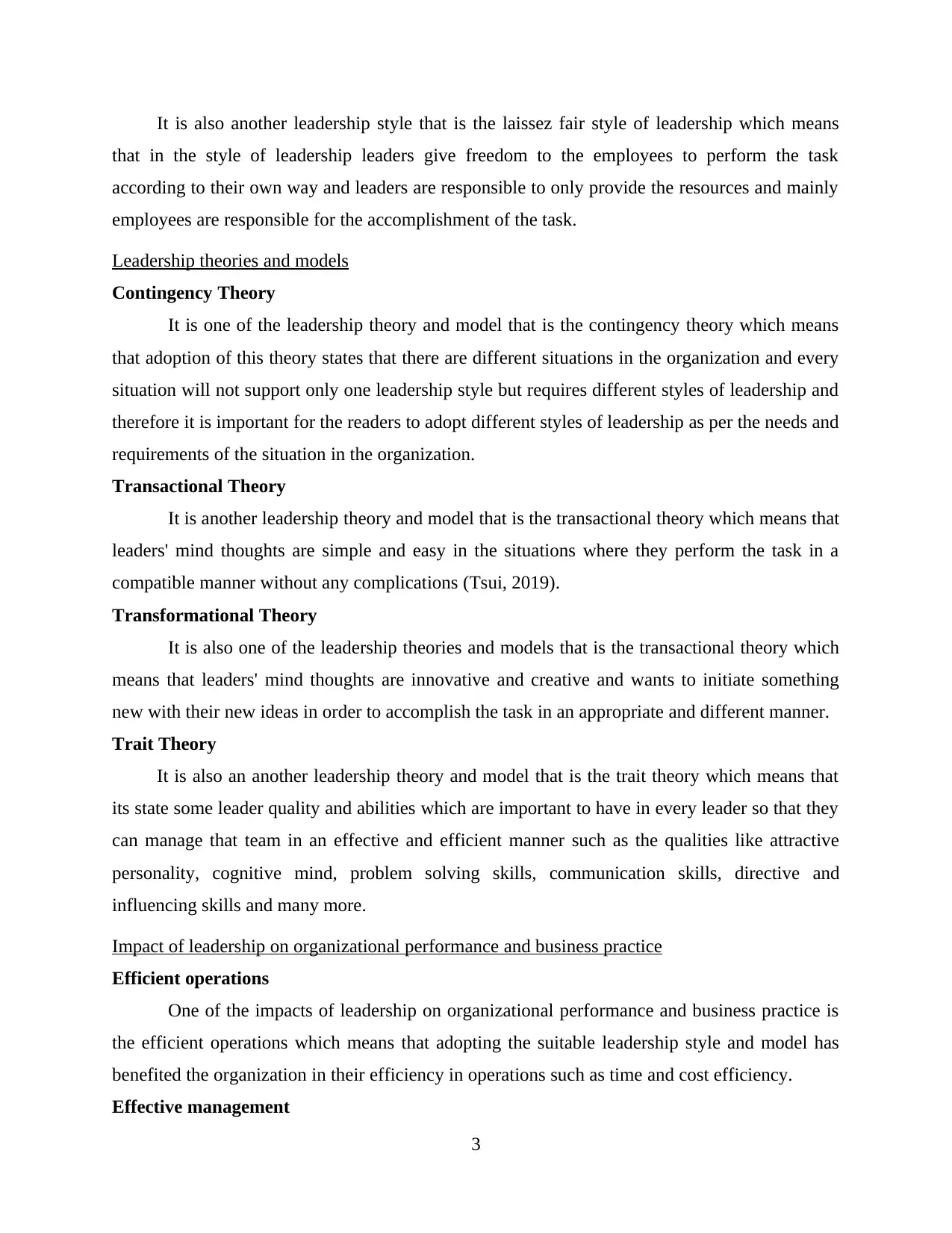
It is also another leadership style that is the laissez fair style of leadership which means
that in the style of leadership leaders give freedom to the employees to perform the task
according to their own way and leaders are responsible to only provide the resources and mainly
employees are responsible for the accomplishment of the task.
Leadership theories and models
Contingency Theory
It is one of the leadership theory and model that is the contingency theory which means
that adoption of this theory states that there are different situations in the organization and every
situation will not support only one leadership style but requires different styles of leadership and
therefore it is important for the readers to adopt different styles of leadership as per the needs and
requirements of the situation in the organization.
Transactional Theory
It is another leadership theory and model that is the transactional theory which means that
leaders' mind thoughts are simple and easy in the situations where they perform the task in a
compatible manner without any complications (Tsui, 2019).
Transformational Theory
It is also one of the leadership theories and models that is the transactional theory which
means that leaders' mind thoughts are innovative and creative and wants to initiate something
new with their new ideas in order to accomplish the task in an appropriate and different manner.
Trait Theory
It is also an another leadership theory and model that is the trait theory which means that
its state some leader quality and abilities which are important to have in every leader so that they
can manage that team in an effective and efficient manner such as the qualities like attractive
personality, cognitive mind, problem solving skills, communication skills, directive and
influencing skills and many more.
Impact of leadership on organizational performance and business practice
Efficient operations
One of the impacts of leadership on organizational performance and business practice is
the efficient operations which means that adopting the suitable leadership style and model has
benefited the organization in their efficiency in operations such as time and cost efficiency.
Effective management
3
that in the style of leadership leaders give freedom to the employees to perform the task
according to their own way and leaders are responsible to only provide the resources and mainly
employees are responsible for the accomplishment of the task.
Leadership theories and models
Contingency Theory
It is one of the leadership theory and model that is the contingency theory which means
that adoption of this theory states that there are different situations in the organization and every
situation will not support only one leadership style but requires different styles of leadership and
therefore it is important for the readers to adopt different styles of leadership as per the needs and
requirements of the situation in the organization.
Transactional Theory
It is another leadership theory and model that is the transactional theory which means that
leaders' mind thoughts are simple and easy in the situations where they perform the task in a
compatible manner without any complications (Tsui, 2019).
Transformational Theory
It is also one of the leadership theories and models that is the transactional theory which
means that leaders' mind thoughts are innovative and creative and wants to initiate something
new with their new ideas in order to accomplish the task in an appropriate and different manner.
Trait Theory
It is also an another leadership theory and model that is the trait theory which means that
its state some leader quality and abilities which are important to have in every leader so that they
can manage that team in an effective and efficient manner such as the qualities like attractive
personality, cognitive mind, problem solving skills, communication skills, directive and
influencing skills and many more.
Impact of leadership on organizational performance and business practice
Efficient operations
One of the impacts of leadership on organizational performance and business practice is
the efficient operations which means that adopting the suitable leadership style and model has
benefited the organization in their efficiency in operations such as time and cost efficiency.
Effective management
3
Paraphrase This Document
Need a fresh take? Get an instant paraphrase of this document with our AI Paraphraser
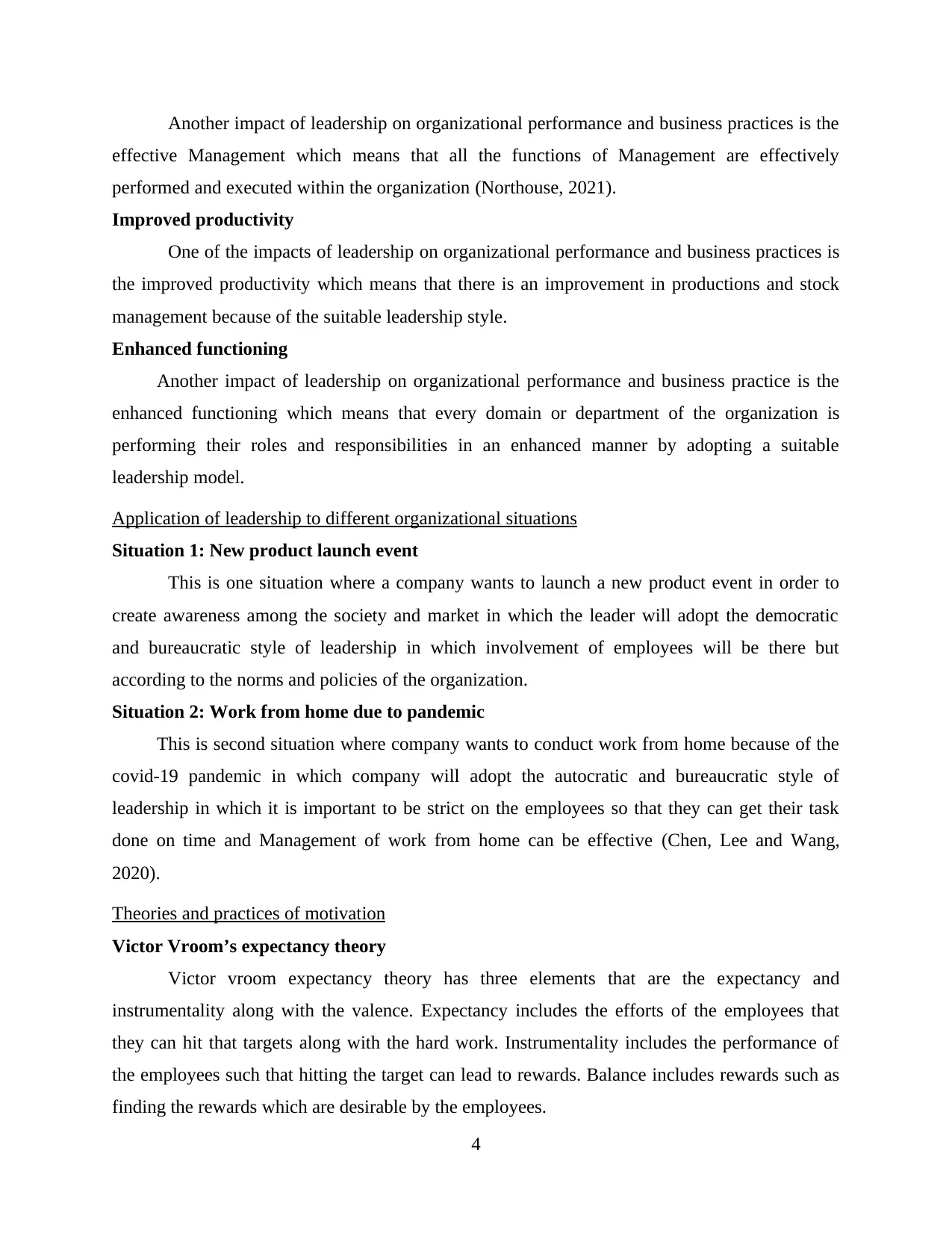
Another impact of leadership on organizational performance and business practices is the
effective Management which means that all the functions of Management are effectively
performed and executed within the organization (Northouse, 2021).
Improved productivity
One of the impacts of leadership on organizational performance and business practices is
the improved productivity which means that there is an improvement in productions and stock
management because of the suitable leadership style.
Enhanced functioning
Another impact of leadership on organizational performance and business practice is the
enhanced functioning which means that every domain or department of the organization is
performing their roles and responsibilities in an enhanced manner by adopting a suitable
leadership model.
Application of leadership to different organizational situations
Situation 1: New product launch event
This is one situation where a company wants to launch a new product event in order to
create awareness among the society and market in which the leader will adopt the democratic
and bureaucratic style of leadership in which involvement of employees will be there but
according to the norms and policies of the organization.
Situation 2: Work from home due to pandemic
This is second situation where company wants to conduct work from home because of the
covid-19 pandemic in which company will adopt the autocratic and bureaucratic style of
leadership in which it is important to be strict on the employees so that they can get their task
done on time and Management of work from home can be effective (Chen, Lee and Wang,
2020).
Theories and practices of motivation
Victor Vroom’s expectancy theory
Victor vroom expectancy theory has three elements that are the expectancy and
instrumentality along with the valence. Expectancy includes the efforts of the employees that
they can hit that targets along with the hard work. Instrumentality includes the performance of
the employees such that hitting the target can lead to rewards. Balance includes rewards such as
finding the rewards which are desirable by the employees.
4
effective Management which means that all the functions of Management are effectively
performed and executed within the organization (Northouse, 2021).
Improved productivity
One of the impacts of leadership on organizational performance and business practices is
the improved productivity which means that there is an improvement in productions and stock
management because of the suitable leadership style.
Enhanced functioning
Another impact of leadership on organizational performance and business practice is the
enhanced functioning which means that every domain or department of the organization is
performing their roles and responsibilities in an enhanced manner by adopting a suitable
leadership model.
Application of leadership to different organizational situations
Situation 1: New product launch event
This is one situation where a company wants to launch a new product event in order to
create awareness among the society and market in which the leader will adopt the democratic
and bureaucratic style of leadership in which involvement of employees will be there but
according to the norms and policies of the organization.
Situation 2: Work from home due to pandemic
This is second situation where company wants to conduct work from home because of the
covid-19 pandemic in which company will adopt the autocratic and bureaucratic style of
leadership in which it is important to be strict on the employees so that they can get their task
done on time and Management of work from home can be effective (Chen, Lee and Wang,
2020).
Theories and practices of motivation
Victor Vroom’s expectancy theory
Victor vroom expectancy theory has three elements that are the expectancy and
instrumentality along with the valence. Expectancy includes the efforts of the employees that
they can hit that targets along with the hard work. Instrumentality includes the performance of
the employees such that hitting the target can lead to rewards. Balance includes rewards such as
finding the rewards which are desirable by the employees.
4
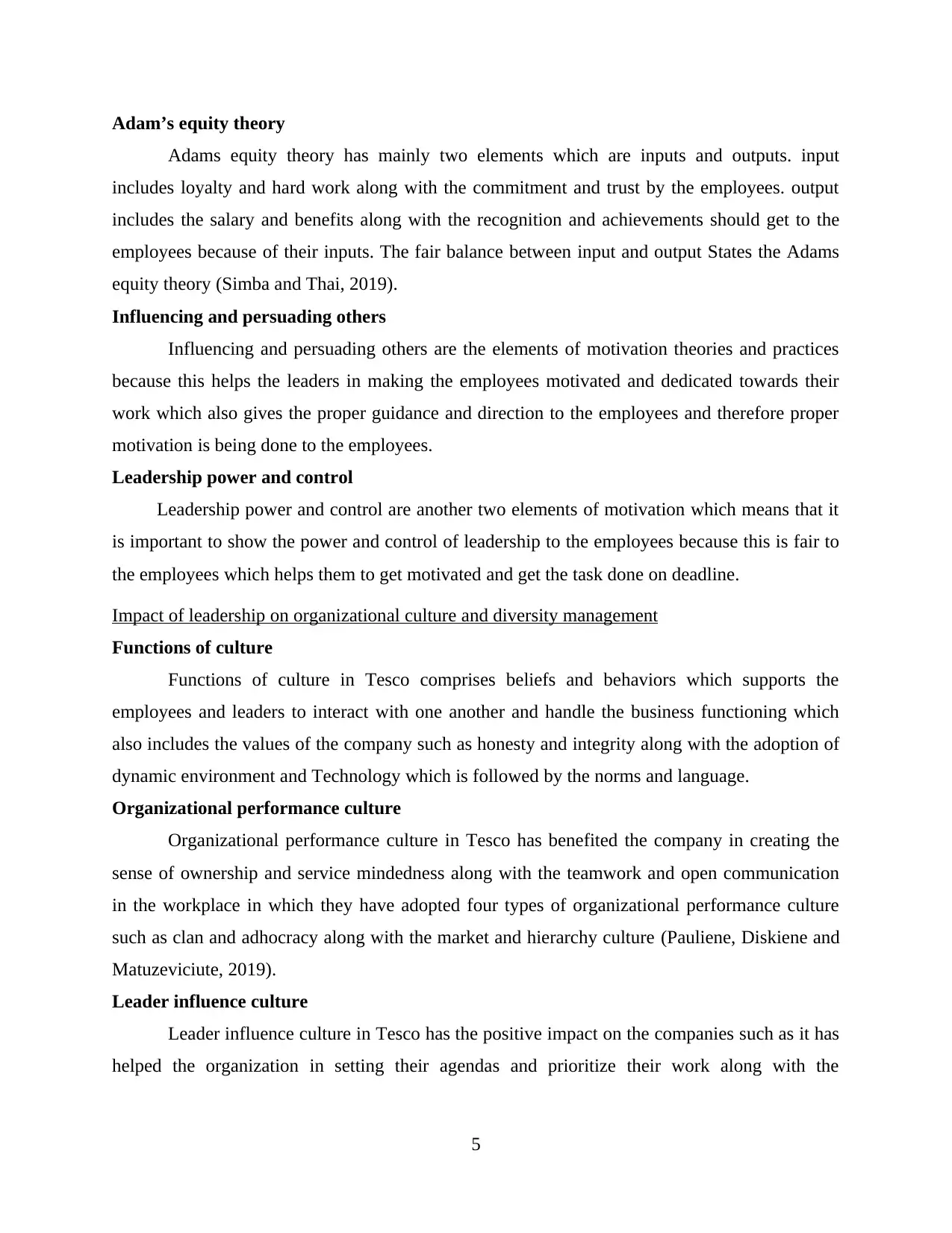
Adam’s equity theory
Adams equity theory has mainly two elements which are inputs and outputs. input
includes loyalty and hard work along with the commitment and trust by the employees. output
includes the salary and benefits along with the recognition and achievements should get to the
employees because of their inputs. The fair balance between input and output States the Adams
equity theory (Simba and Thai, 2019).
Influencing and persuading others
Influencing and persuading others are the elements of motivation theories and practices
because this helps the leaders in making the employees motivated and dedicated towards their
work which also gives the proper guidance and direction to the employees and therefore proper
motivation is being done to the employees.
Leadership power and control
Leadership power and control are another two elements of motivation which means that it
is important to show the power and control of leadership to the employees because this is fair to
the employees which helps them to get motivated and get the task done on deadline.
Impact of leadership on organizational culture and diversity management
Functions of culture
Functions of culture in Tesco comprises beliefs and behaviors which supports the
employees and leaders to interact with one another and handle the business functioning which
also includes the values of the company such as honesty and integrity along with the adoption of
dynamic environment and Technology which is followed by the norms and language.
Organizational performance culture
Organizational performance culture in Tesco has benefited the company in creating the
sense of ownership and service mindedness along with the teamwork and open communication
in the workplace in which they have adopted four types of organizational performance culture
such as clan and adhocracy along with the market and hierarchy culture (Pauliene, Diskiene and
Matuzeviciute, 2019).
Leader influence culture
Leader influence culture in Tesco has the positive impact on the companies such as it has
helped the organization in setting their agendas and prioritize their work along with the
5
Adams equity theory has mainly two elements which are inputs and outputs. input
includes loyalty and hard work along with the commitment and trust by the employees. output
includes the salary and benefits along with the recognition and achievements should get to the
employees because of their inputs. The fair balance between input and output States the Adams
equity theory (Simba and Thai, 2019).
Influencing and persuading others
Influencing and persuading others are the elements of motivation theories and practices
because this helps the leaders in making the employees motivated and dedicated towards their
work which also gives the proper guidance and direction to the employees and therefore proper
motivation is being done to the employees.
Leadership power and control
Leadership power and control are another two elements of motivation which means that it
is important to show the power and control of leadership to the employees because this is fair to
the employees which helps them to get motivated and get the task done on deadline.
Impact of leadership on organizational culture and diversity management
Functions of culture
Functions of culture in Tesco comprises beliefs and behaviors which supports the
employees and leaders to interact with one another and handle the business functioning which
also includes the values of the company such as honesty and integrity along with the adoption of
dynamic environment and Technology which is followed by the norms and language.
Organizational performance culture
Organizational performance culture in Tesco has benefited the company in creating the
sense of ownership and service mindedness along with the teamwork and open communication
in the workplace in which they have adopted four types of organizational performance culture
such as clan and adhocracy along with the market and hierarchy culture (Pauliene, Diskiene and
Matuzeviciute, 2019).
Leader influence culture
Leader influence culture in Tesco has the positive impact on the companies such as it has
helped the organization in setting their agendas and prioritize their work along with the
5
⊘ This is a preview!⊘
Do you want full access?
Subscribe today to unlock all pages.

Trusted by 1+ million students worldwide
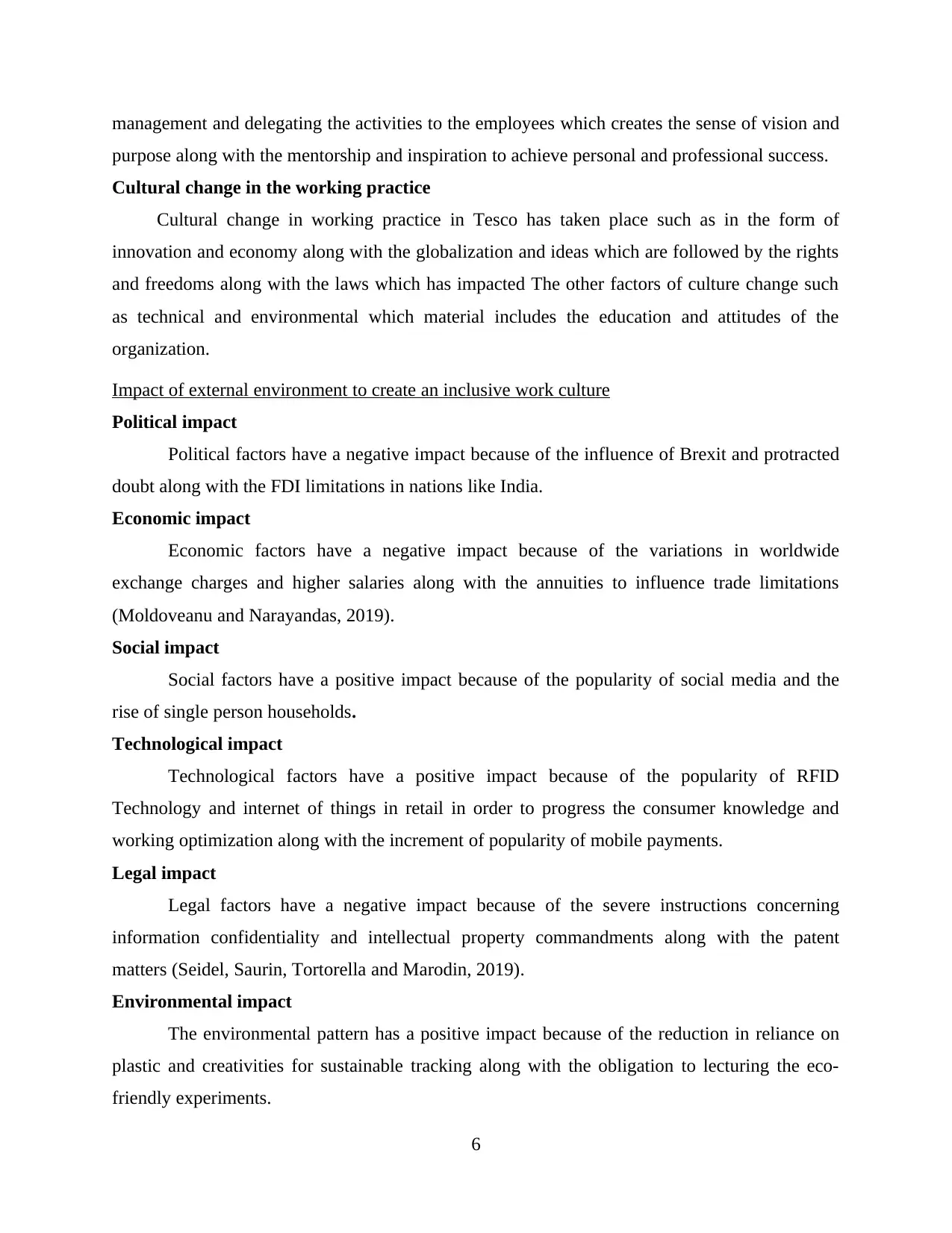
management and delegating the activities to the employees which creates the sense of vision and
purpose along with the mentorship and inspiration to achieve personal and professional success.
Cultural change in the working practice
Cultural change in working practice in Tesco has taken place such as in the form of
innovation and economy along with the globalization and ideas which are followed by the rights
and freedoms along with the laws which has impacted The other factors of culture change such
as technical and environmental which material includes the education and attitudes of the
organization.
Impact of external environment to create an inclusive work culture
Political impact
Political factors have a negative impact because of the influence of Brexit and protracted
doubt along with the FDI limitations in nations like India.
Economic impact
Economic factors have a negative impact because of the variations in worldwide
exchange charges and higher salaries along with the annuities to influence trade limitations
(Moldoveanu and Narayandas, 2019).
Social impact
Social factors have a positive impact because of the popularity of social media and the
rise of single person households.
Technological impact
Technological factors have a positive impact because of the popularity of RFID
Technology and internet of things in retail in order to progress the consumer knowledge and
working optimization along with the increment of popularity of mobile payments.
Legal impact
Legal factors have a negative impact because of the severe instructions concerning
information confidentiality and intellectual property commandments along with the patent
matters (Seidel, Saurin, Tortorella and Marodin, 2019).
Environmental impact
The environmental pattern has a positive impact because of the reduction in reliance on
plastic and creativities for sustainable tracking along with the obligation to lecturing the eco-
friendly experiments.
6
purpose along with the mentorship and inspiration to achieve personal and professional success.
Cultural change in the working practice
Cultural change in working practice in Tesco has taken place such as in the form of
innovation and economy along with the globalization and ideas which are followed by the rights
and freedoms along with the laws which has impacted The other factors of culture change such
as technical and environmental which material includes the education and attitudes of the
organization.
Impact of external environment to create an inclusive work culture
Political impact
Political factors have a negative impact because of the influence of Brexit and protracted
doubt along with the FDI limitations in nations like India.
Economic impact
Economic factors have a negative impact because of the variations in worldwide
exchange charges and higher salaries along with the annuities to influence trade limitations
(Moldoveanu and Narayandas, 2019).
Social impact
Social factors have a positive impact because of the popularity of social media and the
rise of single person households.
Technological impact
Technological factors have a positive impact because of the popularity of RFID
Technology and internet of things in retail in order to progress the consumer knowledge and
working optimization along with the increment of popularity of mobile payments.
Legal impact
Legal factors have a negative impact because of the severe instructions concerning
information confidentiality and intellectual property commandments along with the patent
matters (Seidel, Saurin, Tortorella and Marodin, 2019).
Environmental impact
The environmental pattern has a positive impact because of the reduction in reliance on
plastic and creativities for sustainable tracking along with the obligation to lecturing the eco-
friendly experiments.
6
Paraphrase This Document
Need a fresh take? Get an instant paraphrase of this document with our AI Paraphraser
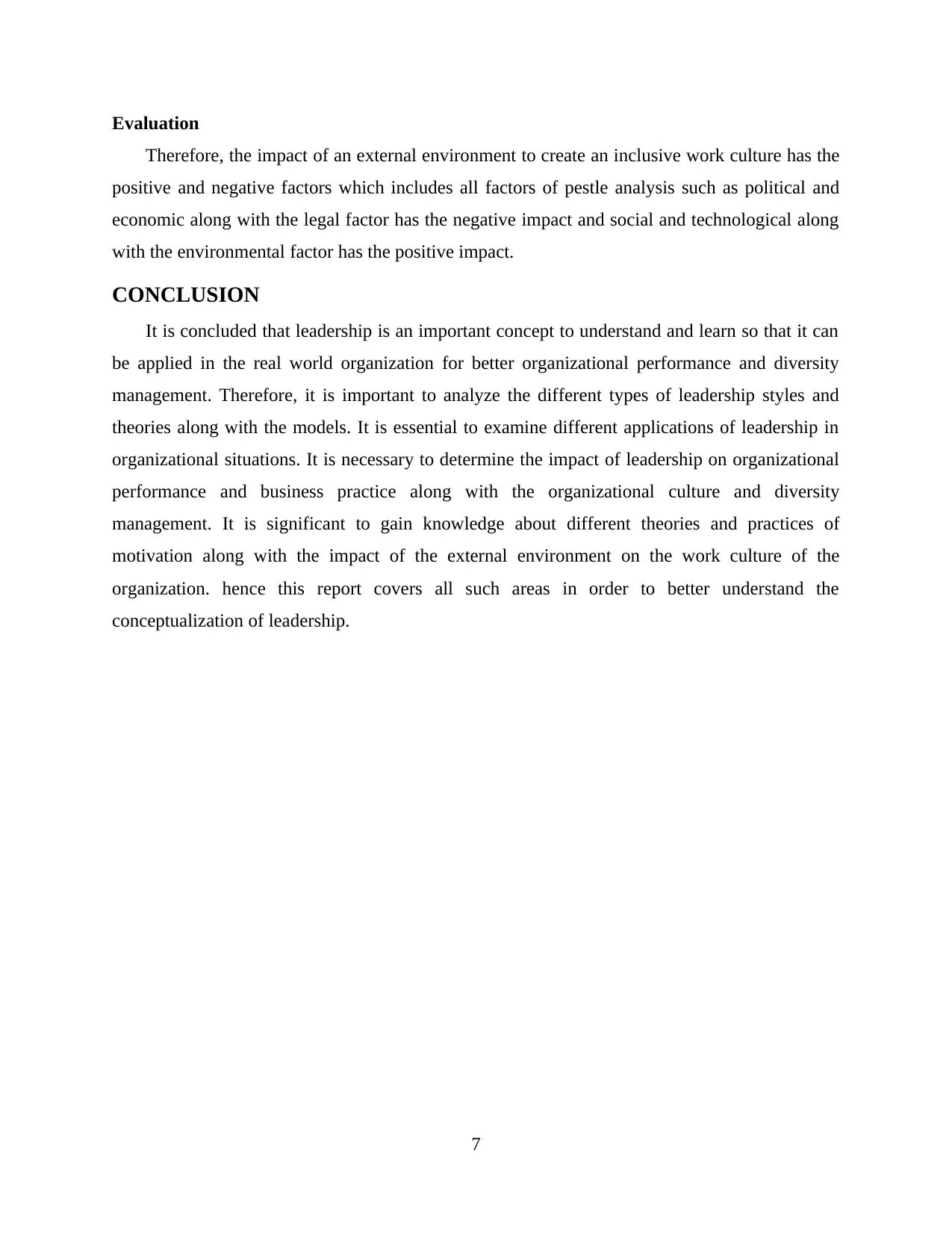
Evaluation
Therefore, the impact of an external environment to create an inclusive work culture has the
positive and negative factors which includes all factors of pestle analysis such as political and
economic along with the legal factor has the negative impact and social and technological along
with the environmental factor has the positive impact.
CONCLUSION
It is concluded that leadership is an important concept to understand and learn so that it can
be applied in the real world organization for better organizational performance and diversity
management. Therefore, it is important to analyze the different types of leadership styles and
theories along with the models. It is essential to examine different applications of leadership in
organizational situations. It is necessary to determine the impact of leadership on organizational
performance and business practice along with the organizational culture and diversity
management. It is significant to gain knowledge about different theories and practices of
motivation along with the impact of the external environment on the work culture of the
organization. hence this report covers all such areas in order to better understand the
conceptualization of leadership.
7
Therefore, the impact of an external environment to create an inclusive work culture has the
positive and negative factors which includes all factors of pestle analysis such as political and
economic along with the legal factor has the negative impact and social and technological along
with the environmental factor has the positive impact.
CONCLUSION
It is concluded that leadership is an important concept to understand and learn so that it can
be applied in the real world organization for better organizational performance and diversity
management. Therefore, it is important to analyze the different types of leadership styles and
theories along with the models. It is essential to examine different applications of leadership in
organizational situations. It is necessary to determine the impact of leadership on organizational
performance and business practice along with the organizational culture and diversity
management. It is significant to gain knowledge about different theories and practices of
motivation along with the impact of the external environment on the work culture of the
organization. hence this report covers all such areas in order to better understand the
conceptualization of leadership.
7
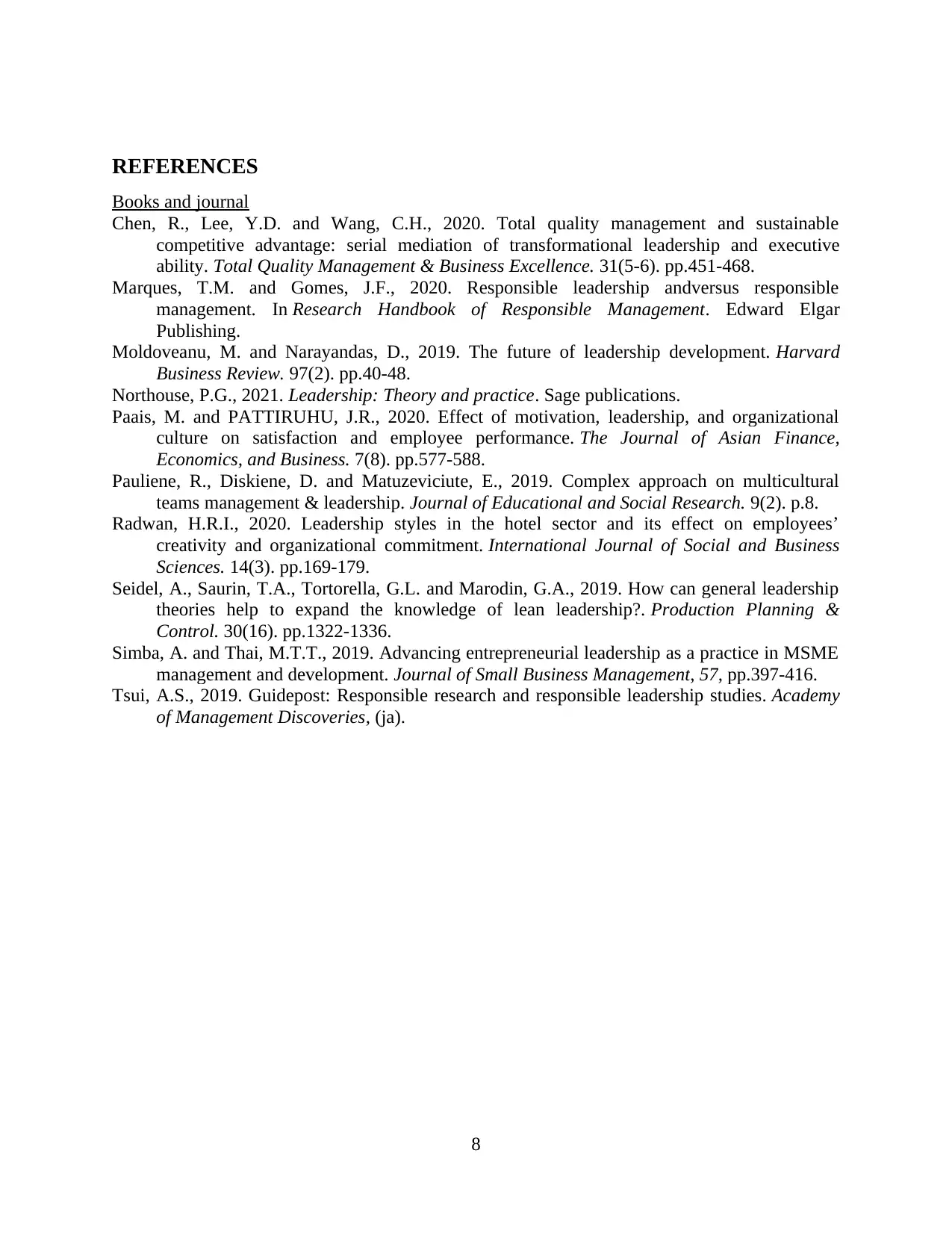
REFERENCES
Books and journal
Chen, R., Lee, Y.D. and Wang, C.H., 2020. Total quality management and sustainable
competitive advantage: serial mediation of transformational leadership and executive
ability. Total Quality Management & Business Excellence. 31(5-6). pp.451-468.
Marques, T.M. and Gomes, J.F., 2020. Responsible leadership andversus responsible
management. In Research Handbook of Responsible Management. Edward Elgar
Publishing.
Moldoveanu, M. and Narayandas, D., 2019. The future of leadership development. Harvard
Business Review. 97(2). pp.40-48.
Northouse, P.G., 2021. Leadership: Theory and practice. Sage publications.
Paais, M. and PATTIRUHU, J.R., 2020. Effect of motivation, leadership, and organizational
culture on satisfaction and employee performance. The Journal of Asian Finance,
Economics, and Business. 7(8). pp.577-588.
Pauliene, R., Diskiene, D. and Matuzeviciute, E., 2019. Complex approach on multicultural
teams management & leadership. Journal of Educational and Social Research. 9(2). p.8.
Radwan, H.R.I., 2020. Leadership styles in the hotel sector and its effect on employees’
creativity and organizational commitment. International Journal of Social and Business
Sciences. 14(3). pp.169-179.
Seidel, A., Saurin, T.A., Tortorella, G.L. and Marodin, G.A., 2019. How can general leadership
theories help to expand the knowledge of lean leadership?. Production Planning &
Control. 30(16). pp.1322-1336.
Simba, A. and Thai, M.T.T., 2019. Advancing entrepreneurial leadership as a practice in MSME
management and development. Journal of Small Business Management, 57, pp.397-416.
Tsui, A.S., 2019. Guidepost: Responsible research and responsible leadership studies. Academy
of Management Discoveries, (ja).
8
Books and journal
Chen, R., Lee, Y.D. and Wang, C.H., 2020. Total quality management and sustainable
competitive advantage: serial mediation of transformational leadership and executive
ability. Total Quality Management & Business Excellence. 31(5-6). pp.451-468.
Marques, T.M. and Gomes, J.F., 2020. Responsible leadership andversus responsible
management. In Research Handbook of Responsible Management. Edward Elgar
Publishing.
Moldoveanu, M. and Narayandas, D., 2019. The future of leadership development. Harvard
Business Review. 97(2). pp.40-48.
Northouse, P.G., 2021. Leadership: Theory and practice. Sage publications.
Paais, M. and PATTIRUHU, J.R., 2020. Effect of motivation, leadership, and organizational
culture on satisfaction and employee performance. The Journal of Asian Finance,
Economics, and Business. 7(8). pp.577-588.
Pauliene, R., Diskiene, D. and Matuzeviciute, E., 2019. Complex approach on multicultural
teams management & leadership. Journal of Educational and Social Research. 9(2). p.8.
Radwan, H.R.I., 2020. Leadership styles in the hotel sector and its effect on employees’
creativity and organizational commitment. International Journal of Social and Business
Sciences. 14(3). pp.169-179.
Seidel, A., Saurin, T.A., Tortorella, G.L. and Marodin, G.A., 2019. How can general leadership
theories help to expand the knowledge of lean leadership?. Production Planning &
Control. 30(16). pp.1322-1336.
Simba, A. and Thai, M.T.T., 2019. Advancing entrepreneurial leadership as a practice in MSME
management and development. Journal of Small Business Management, 57, pp.397-416.
Tsui, A.S., 2019. Guidepost: Responsible research and responsible leadership studies. Academy
of Management Discoveries, (ja).
8
⊘ This is a preview!⊘
Do you want full access?
Subscribe today to unlock all pages.

Trusted by 1+ million students worldwide
1 out of 12
Related Documents
Your All-in-One AI-Powered Toolkit for Academic Success.
+13062052269
info@desklib.com
Available 24*7 on WhatsApp / Email
![[object Object]](/_next/static/media/star-bottom.7253800d.svg)
Unlock your academic potential
Copyright © 2020–2025 A2Z Services. All Rights Reserved. Developed and managed by ZUCOL.





